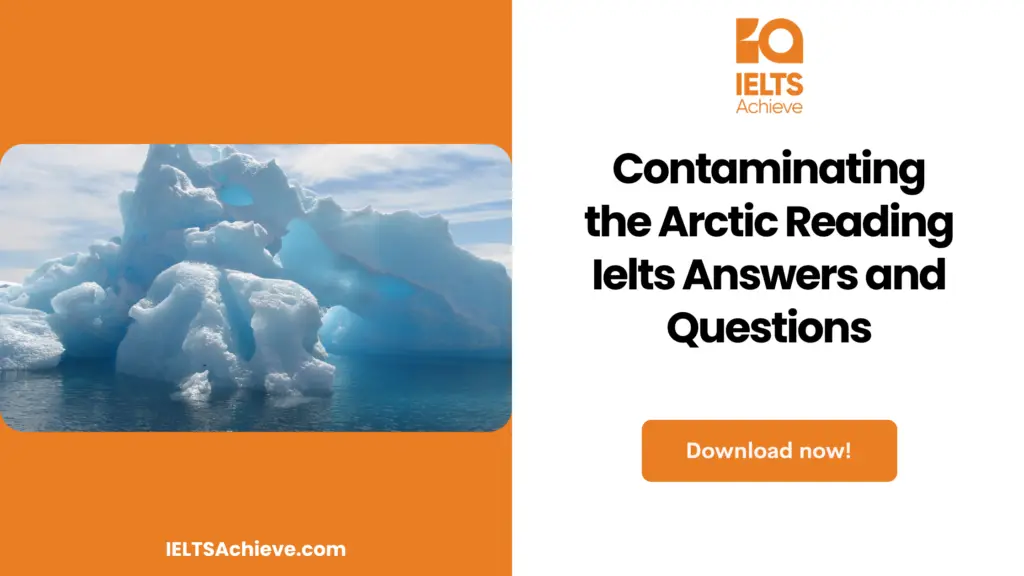The Blog post contains the following IELTS Reading Questions
- IELTS Reading true/false/not given
- IELTS Reading note completion
- IELTS Reading short answer questions
Stay informed and prepared for success – Explore our comprehensive Reading Test Info page to get valuable insights, exam format details, and expert tips for mastering the IELTS Reading section.
IELTS Reading Passage – Contaminating the Arctic

Contaminating the Arctic
Our perception of the Arctic region is that its distance from industrial centers keeps it pristine and clear from the impact of pollution. However, the Arctic is the recipient of contaminants whose sources are thousands of miles away through a process known as transboundary pollution. Large quantities of pollutants pour into our atmosphere, as well as our lakes, rivers, and oceans on a daily basis. In the last two decades, scientists have detected an increasing variety of toxic contaminants in the North, including pesticides from agriculture, chemicals and heavy metals from industry, and even radioactive fall-out from Chernobyl. These are substances that have invaded ecosystems virtually worldwide, but they are especially worrisome in the Arctic.Initially, Chemical spills were primarily attributed for Arctic contamination which were also believed to be “small and confined”. Pollutants from all across the world are now considered to be transferred north by rivers, ocean currents, and atmospheric circulation. Moreover, Contaminants break down significantly more slowly in the Arctic than in warmer climates due to harsh conditions such as reduced sunlight, extensive ice cover, and frigid temperatures. Due to their lengthened lifespan in the Arctic, contaminants can also become significantly concentrated.Problems of spring run-off into coastal waters during the growth period of marine life are of critical concern. Spring algae blooms easily, absorbing the concentrated contaminants released by spring melting. These algae are in turn eaten by zooplankton and a wide variety of marine life. The accumulation of these contaminants increases with each step of the food chain or web and can potentially affect northerners who eat marine mammals near the top of the food chain. Pollutants respect no borders; transboundary pollution is the movement of contaminants across political borders, whether by air, rivers, or ocean currents. The eight circumpolar nations, led by the Finnish Initiative of 1989, established the Arctic Environmental Protection Strategy (AEPS) in which participants have agreed to develop an Arctic Monitoring and Assessment Program (AMAP). AMAP establishes an international scientific network to monitor the current condition of the Arctic with respect to specific contaminants. This monitoring program is extremely important because it will give a scientific basis for understanding the scope of the problem.In the 1950s, during the springtime bands of haze were reported by pilots traveling on weather reconnaissance flights in the Canadian high Arctic. During this period, the term “Arctic haze” was first used, referring to this mist of uncertain origin. Dr. Glenn Shaw of the Geophysical Institute at the University of Alaska was the first to put forth theories on the nature and long-distance origin of Arctic haze in 1972. The notion that the source was distant was difficult for many to support. Each winter, air that is frigid and dense descends over the Arctic. Mid-latitude emissions from fossil fuel combustion, smelting, and other industrial operations seem to be accumulating in the Arctic in the darkness, causing an increase in pollution. By late winter, the Arctic has been blanketed in a layer of this haze the size of Africa. When spring light arrives in the Arctic, there is a haze that resembles smog, which gives the region an appearance of pollution over places like Los Angeles. This polluted air is a well-known and well-distinctive feature of the late winter Arctic environment. In the Arctic of North America, instances of brown or black snow have been linked to continental storm tracks that transport gaseous and particulate-associated contaminations from Asian deserts and agricultural regions. The contaminants are now thought to have originated primarily in Europe and Asia.Arctic haze has been studied most extensively in Point Barrow, Alaska, across the Canadian Arctic and in Svalbard (Norway). Evidence from ice cores drilled from the ice sheet of Greenland indicates that these haze particles were not always present in the Arctic, but began to appear only in the last century. The Arctic haze particles appear to be similar to smog particles observed in industrial areas farther south, consisting mostly of sulfates mixed with particles of carbon. It is believed the particles are formed when gaseous sulfur dioxide produced by burning sulfur-bearing coal is irradiated by sunlight and oxidized to sulfate, a process catalyzed by trace elements in the air. These sulfate particles or droplets of sulfuric acid quickly capture the carbon particles, which are also floating in the air. Pure sulfate particles or droplets are colorless, so it is believed the darkness of the haze is caused by the mixed-in carbon particlesThe impact of the haze on Arctic ecosystems and the global environment, has not been adequately researched. The pollutants have only been studied in their aerosol form over the Arctic. However, a brief is known about what eventually happens to them. It is known that they are removed somehow. There is a good degree of likelihood that the contaminants end up in the ocean, likely into the North Atlantic, the Norwegian Sea and possibly the Bering Sea — all three very important fisheries.Currently, the major issue among researchers is to understand the impact of Arctic haze on global climate change. The contaminants absorb sunlight and, in turn, heat up the atmosphere. The global impact of this is currently unknown but the implications are quite powerful.
Unlock your full potential in the IELTS Reading section – Visit our IELTS Reading Practice Question Answer page now!
Recommended Questions:
Renewable Energy IELTS Reading Question with Answer
Questions
Questions 1-5
Do the following statements agree with the information given in Reading Passage 1? In boxes 1-5 on your answer sheet, write
TRUE if the statement agrees with the information
FALSE if the statement contradicts the information
NOT GIVEN if there is no information on this
- Arctic pollution can sometimes resemble US urban pollution.
- The AEPS has set up scientific stations in the Arctic to monitor pollution
- Research has shown that aerosol arctic pollutants remain in the air indefinitely.
- Arctic conditions mean that the breakdown of pollutants is much accelerated
- Pollution absorbed by Arctic algae can eventually affect humans.
Enhance your skills in identifying information as True, False, or Not Given. Click here to discover expert strategies and techniques for mastering this question type in the IELTS Reading section.
Questions 6-11
Fill in the blanks in the Arctic Haze summary below. Fill in the blanks in boxes 21-26 on your response sheet with your answers from the box below the summary.
NB There are more words than spaces, so you will not use them at all
Example
Answer ……………………….. that the origins of spring, arctic haze,
Theories first seen over the ice cap…(eg) ______________________ that the origins of spring, arctic haze, first seen over the ice cap in the 1950s, came from far away were at first not (6) _______________ _______. This haze is a smog formed in the dark, arctic winter by pollution delivered to the Arctic by storms (7) ______________________ in Europe and Asia. It is known to be a recent phenomenon as proof from (8) ______________________ shows it only starting to occur in the 20th Century. The smog consists of sulfates and carbon, the latter creating the (9) ______________________ of the haze. Due to lack of research, the final destination of the pollution is unknown but it probably ends up in the (10) ______________________ and therefore into the food chain. Scientists are presently more worried about the (11) ______________________ effect it has on climate change.
| density | Unknown | darkness | gasses | accepted |
| terrible | originating | dissipating | air | birdlife |
| burning | theories | destroying | certain | valid |
| decided | agriculture | ice cores | sea |
Questions 12 and 13
Answer the questions below.
Write NO MORE THAN THREE WORDS AND/ OR A NUMBER from the passage for each answer.
12. During which era, the term “Arctic Haze” was firstly used?
13. Initially, what was the primary attribution for Arctic contamination ?
Unlock your full potential in the IELTS Reading section – Visit our IELTS Reading Practice Question Answer page now!
Recommended Questions:
Renewable Energy IELTS Reading Question with Answer
Contaminating the Arctic IELTS Reading Answers
1 Answer: False
2 Answer: True
3 Answer: False
4 Answer: True
5 Answer: Not Given
6 Answer: CERTAIN
7 Answer: ORIGINATING
8 Answer: ICE CORES
9 Answer: DARKNESS
10 Answer: SEA
11 Answer: UNKNOWN
12 Answer: Springtime bands
13 Answer: Chemical spills

We hope you found this post useful in helping you to study for the IELTS Test. If you have any questions please let us know in the comments below or on the Facebook page.
The best way to keep up to date with posts like this is to like us on Facebook, then follow us on Instagram and Pinterest. If you need help preparing for the IELTS Test, join the IELTS Achieve Academy and see how we can assist you to achieve your desired band score. We offer an essay correction service, mock exams and online courses.

